http://www.antiatlas-journal.net/pdf/03-harris-gayle-an-invitation-to-category-theory-for-designers
antiAtlas Journal #3, 2019
An Invitation to Category Theory for Designers
Edmund Harriss et Rhett Gayle
Abstract systems such as the drawing, musical notation and weaving patterns are not new to art and design. Yet, with the introduction of computers, the range of possible abstractions and the relationship between them is only growing. The mathematical tools developed in category theory, the study of abstract spaces and the maps between them, give a powerful tool to map abstract systems and systems of abstract systems, and can be applied to systems as diverse as ninth century religious imagery and modern architectural form. At a more detailed level it provides a design metaphor for CAM (Computer Aided Manufacturing) software and visual programming environments such as Grasshopper.
This paper introduces the fundamental concepts of category theory and then shows how they can be applied to a wide variety of situations from design to the wider world.
Edmund Harriss is a Mathematician, Teacher, Artist and Maker at the University of Arkansas. His work explores unusual applications of mathematics and geometry, and how to communicate the power and beauty of mathematical thinking beyond technical manipulation.
Rhett Gayle teaches philosophy at the University of Colorado, Boulder, while residing in Scotland. His research interests include: philosophy and psychology, especially the philosophical import of various areas of cognitive neuroscience; as well as political philosophy, focusing on issues related to the emergence of a planetary civilization.
Keywords: abstraction, biomimetics, design, space, mapping, mathematics, modeling, production process, programming, category theory
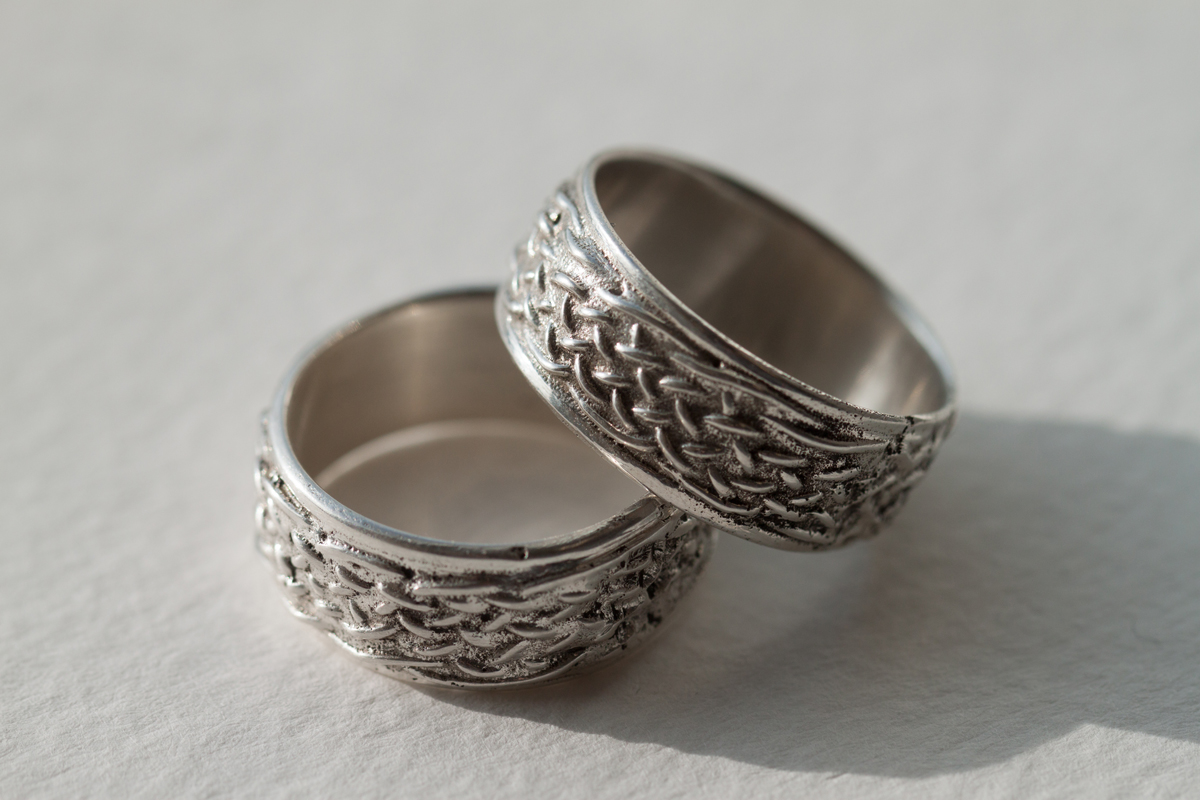
Sand cast alloys, designed from a woven pattern © Edmund Harriss
To quote this article: Harriss, Edmund et Gayle, Rhett, " An Invitation to Category Theory for Designers " in antiAtlas Journal #3 | 2019, Online, URL : http://www.antiatlas-journal.net/03-an-invitation-to-category-theory-for-designers, last consultation on Date
Introduction
1 Metaphor and abstraction have been at the heart of art since its beginning, certainly long before the specific notion of abstract art. They can also be seen as central to the study of mathematics, with a reading of the subject as the precise study of a family of metaphors. That precision has enabled mathematicians to dive deep into abstraction building metaphors that help to explain metaphors. One of the deepest subjects within this area of study is the notion of Category Theory (MacLane 2010) a consideration of abstract spaces and the ways that you can move between them. At its heart is a simple visual metaphor of objects connected by arrows. The objects are considered to be spaces with structure and the arrows give maps taking elements from one space into another. A key insight is that the objects under consideration are the spaces themselves, rather than the specific items they might contain.
In the spirit of mathematics as metaphor (Manin 2007), we wish to recast Category Theory here as a game, a way to think about structures of ideas and process. The role of mathematics considered here is essentially one of perception (Harriss et al. 2019), an attempt to draw out hidden structure and metaphor, or to create metaphor with the intention of learning. The test for success, therefore, is not the depth, or even correctness, of the mathematical thinking but the question of whether new and useful insights are created about the idea, object, problem, or aesthetic under consideration. Within this framework we will consider both conceptual and more practical processes, with a particular focus on the consideration of how computer representations and algorithms can be brought into an artistic flow.
The notion of space here is deliberately a little vague, from more obvious spaces, like possible positions in the room, through more unusual ones, like the collection of objects in the room, to the incredibly abstract, for example the collection of all conversations that could take place in the room.
We will only look at the surface of the subject from a mathematician’s standpoint, but hopefully show enough to inspire ideas or even a deeper study (Lawvere and Schanuel 1998, Badiou 2014). To reiterate, the goal is not to push towards rigorous models but to inspire metaphor. The test for success is whether in a given situation the ideas discussed here provide insights.
next...
I. The value of abstraction

2 Begin with a simple exercise. Take a look around and find some objects you could count. They can be simple or complex. Find some things you can give a number to just by looking, some things you would have to count easily, and some things that you could count but which might take a while. You have just engaged in a simple mathematical model of aspects of the world around you, that might be summed up as follows.
next...

3 This is our first arrow to interrogate. A couple of key questions immediately come to mind. It is clear that some information is retained, but also much is lost. In order to count you had to take different objects and identify something about them that was the same. Books are a great example. Each is filled with distinct knowledge and stories, but to count them I only have to think of them as books, the information is lost in the established map. So, for any arrow that we draw there is always a question, to consider both what structure is retained as well as being aware of what structure is lost.
A great example, from architecture, is the drawing. The abstract space of drawing allows ideas to be explored. A drawing represents enough of the structure of a building that ideas can be tested out quickly and inexpensively. After the form of a building is decided upon, the drawings play a further role communicating the design to others. Models provide a different representation retaining more of the three-dimensional structure. The emphasis on the architect as author, not constructor, show the importance of abstraction in the ideas of architecture, at least from Leon Battista Alberti’s De re aedificatoria in the fifteenth century, and onwards (Alberti 1988, Carpo 2011).
At this point it is worth noting one rule that we want to apply to our arrows. As we describe what they do, for any input we need some sense of a unique output. If we really want rigour (or are working on a computer) then this is a strong requirement, but the world of metaphor does give some wiggle room. The correct arrow here is therefore not from drawing to building, for a single drawing could produce buildings multiple times. The opposite arrow, from building to drawing captures the sense better. If we were to define carefully the rules for a drawing a building could be captured. So, the arrow we want to consider here is:
next...
4 Many other abstractions have been used within crafts for the length of human existence: musical scores and dance notation (Taruskin 2009), knitting and weaving patterns (Albers 1965, Nargi 2011), the stick models used by ancient pacific navigators to show wave patterns (Lewis 1994), and even language itself. In each case these abstract models provide a similar collection of benefits. They make it possible to repeat a situation, possibly with changes and permutations. They help divide up a problem, cutting away less important properties, making it easier to focus on different aspects independently. Finally, they enable that simplified space to be explored more efficiently, enabling new discoveries.
The computer introduces many new worlds of abstraction. More importantly it provides an automated way of moving between abstract spaces. A 3d model of a building opens up many possibilities. It can produce detailed drawings that can be printed out and, with 3d printing, produce physical models. With the right information added, it can give running totals of materials needed and overall costs. It can even be made parametric, changing shape based on numbers, such as the size of the plot, or even more complicated inputs such as curves or photographs. A single system can therefore produce an incredible array of designs for different buildings, which can be turned automatically into plans and models.
In any consideration of abstraction, the computer should just be considered as a new tool. It is, however, a tool that makes abstraction itself more powerful. With a computer the process of making choices and following abstract rules can be done automatically. This enables logical processing of an abstract model, rather than simply representation. The primary model has moved from the raw representation of the alphabet and drawing to the algorithm (Carpo 2011). This enables a faster processing of abstract systems that can be described on the computer. It also makes it far easier to create new abstract worlds and to explore their potentials.
Mathematics faced a similar situation in the nineteenth century as it started to study abstraction itself, rather than simply abstractions from the world (Gray 2008). The solution was to apply abstract techniques to abstraction. The parallel for designers is to apply design thinking to the process of design, making it possible to understand skills already developed so that they can be applied to the new possibilities opened up by computers.
next...
II. Abstraction of abstraction

5 Now consider a sunny day at noon on the equator (so the sun is directly overhead). In the sky a bird is flying and casting a shadow on the ground. The shadow moves with the bird, so we have a new arrow.
next...

6 The position of the shadow gives some information about the bird. Yet we can be explicit that something that is missing. Two birds can have the same shadow. We can bring in a second map.
next...
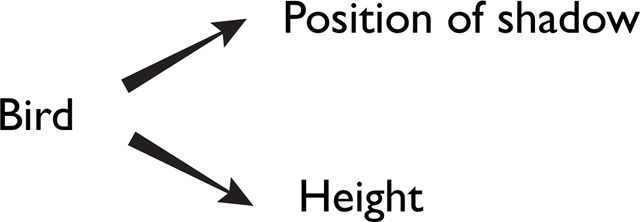
7 The fact that the same thing (bird) appears in both maps means that we can combine them into a single picture.
next...

8 The goal here is to create a diagram and then use it to ask questions. In this case we have explicitly identified information that was lost by finding a second map, so we can try to combine the two pieces, shadow and height. Formally we call this a product. From this we magically produce a new space (height, shadow position) from which we can pull out either element.
next...

9 We can now ask if we can describe this new combined space, and perhaps fill in some of the missing arrows. In this case the combined information about shadow and height describes the position of the bird, and we can create a new arrow which links the bird to its position.
next...

10 Combining the two descriptions of the bird gives a richer understanding, yet it is still missing a lot of information. For example, the direction of the bird, or its species. Depending on what we wish to study these may or may not be useful. In this case the bird is simply a metaphor itself, creating a diagram. The same diagram can be applied to many different things. Take Paul Klee’s famous notion “Art does not reproduce the visible; rather it makes visible”:
next...

This creates the same starting frame:
11 As soon as we have this frame we can ask if it can be extended in the same way. Giving with the natural (and possibly interesting) questions of what the richer perception entails and how it informs the original experience.
next...

12 To consider abstraction itself we begin with the very loose idea of a set or space, some collection of objects that can be described. The set of all possible houses for example, or the space of all drawings of houses. We now look in more detail at the second notion we have been using, the arrow. We can return to the process of building (or simply imagining) a possible house from some drawings. Recall that one of the strengths of abstraction is that it helps us to concentrate only on the important properties of the system we wish to study. In this case, therefore, we can ignore the fact that the translation between drawing and building is a difficult one obtained through several years study, and just consider that it exists, being summed up in the following diagram:
next...

13 This is very simple, but with the computer we can consider more complicated situations. For example, with a computer model, we can automatically create both drawings and 3d printed models. This produces a diagram not that different to the one above. In this case though we have started with two different spaces each losing information as they map down to two representations. Can we add any reasonable arrows to the diagram? A single computer model, like a drawing, can be used to create multiple drawings, but it can also itself be the source for multiple buildings and models:
next...
14 In this case each map is simply between spaces, so we might want to consider, in addition, whether the potential house described by the drawing and the 3d model are the same. We might also consider whether the potential house that the client translates from the model and the drawings is the same as the one the architect is considering. Here is a second example that demonstrates the value of the separation of problems, the reusability and the exploration possible in an abstract system. When the first author, Edmund Harriss was designing his wedding rings he took a weaving pattern he had designed on the computer and wove it in copper wire. This was wrapped round a blank, and the over-cuts filled with epoxy so he could make a mold and sand-cast the rings. Finally, they were polished and finished.
next...

Sand cast alloys, designed from a woven pattern © Edmund Harriss
15 A simple process that could be repeated, not just with one pattern but with any weaving pattern you could design. The computer scripts used to design the weaving pattern also included an input space, mathematical permutations, from which weaving patterns were produced. We can consider the process like this:
next...

16 In this case the operations are a lot more concrete than those discussed above. Yet they still require some effort to be developed. By considering this little model, however, we end up with a significantly more flexible system. The input permutation can be changed without incurring new development costs (there would of course still be some manufacturing costs). A significant aspect of the final design of the rings can therefore be left to the end of the process. Additionally, as the two methods are split, it would be possible to introduce a more sophisticated method of creating weaving patterns. These could then be turned into rings reusing part of this process. Similarly, the script to create weaving patterns could be used in other ways.
next...

17 For example, a script could turn the weaving patterns into three dimensional models, allowing a wide range of different patterns to be quickly explored.The abstract approach breaks the problem into pieces and reveals potential new developments. Category theory provides a general approach to such thinking.
next...
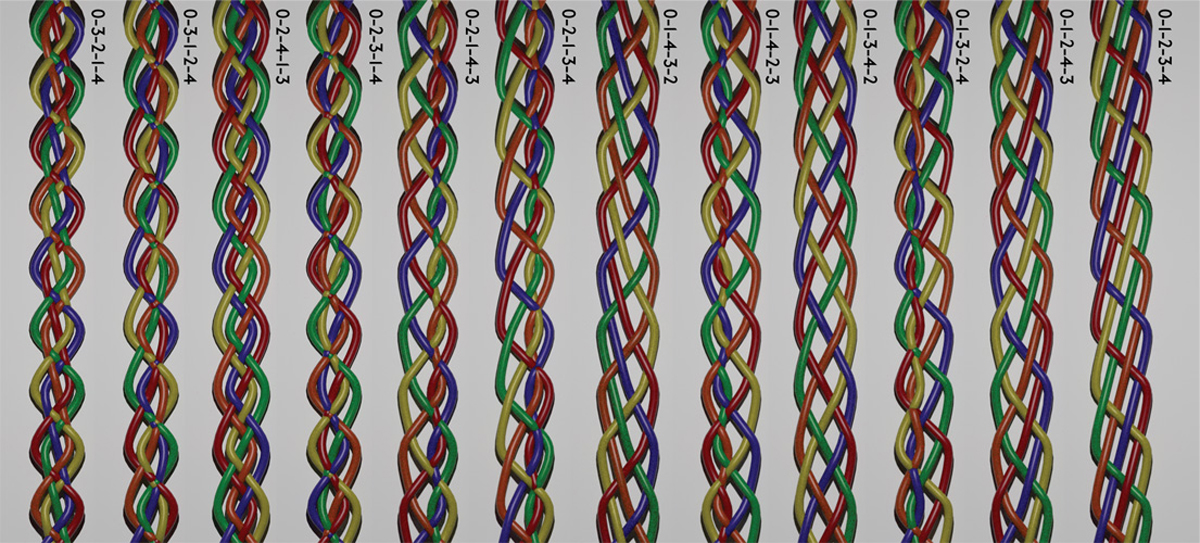
A collection of weaving patterns created by an automatic process from mathematical permutations.
© Edmund Harriss
III. The Category Theory Game
18 At the heart of category theory are three simple ideas: spaces, considered as objects in themselves; correspondences between spaces; structures preserved by correspondences. The real object though is just the objects (dots or words) and the arrows between them. For example, with three objects and two arrows there are three different objects to draw:
next...

19If the objects were distinct you would of course have a choice as to how they fitted into the three dots. With these drawings in hand for the simple set up of your ideas and their relationships you can now ask questions, for example, if two collections have the same structure what useful questions can a form transfer from one to the other? Another standard question is to ask what arrows are missing. But to get to that, we need to think a bit more carefully about the arrows.
Each arrow is defined by three things, the domain, the space it maps from, the codomain, the space it takes elements to, and some rule or method that associates each element of the domain with an element of the codomain. As described above this rule should aim to give a unique and consistent output for any input. A natural arrow should describe a process, but it can be repeated, with the natural rule inverted, taking a product back to the generating plan.
Once the arrows are defined we must ask what arrows are missing. In the triangles above the possible arrows move from the top to the bottom dots. The central image is perhaps the simplest. Arrows can be naturally combined. If the codomain of one map is the same as the domain of another then we can create a third map. For example, if we have a map from classes to room numbers and another map from room numbers to the number of people in a class, we can combine the two to get a new map giving the number of people in a class:
next...

20 So, any time an arrow comes in and another one goes out they can be combined. This creates two routes between one space and another. In this case the two routes give by definition the same result. If all routes through the arrows around the diagram give the same result, we say that the diagram commutes.
The third concept is perhaps the most important. The spaces under consideration have some sort of structure. The most interesting maps are those that preserve all or some of that structure. A simple example would be transposing a piece of music. Although the resulting piece is certainly distinct it retains all of the structure of the original. Architectural drawings have a similar property, though in this case, when we apply the map (from the space of possible buildings) only some structure is retained. The value of the drawings is that the structure that is retained is of great importance.
In both these examples the notion of preserving structure goes even further. Operations in the domain correspond to operations in the codomain. For example, changing notes in a piece of music correspond to a similar change in its transposed version. Consider the following diagram:
next...
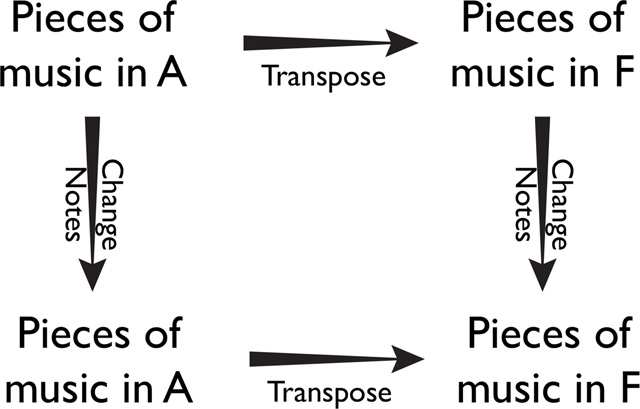
21 The operations which change the notes in the key of A and the key of F will be different, but the same operation applied to two pieces in A will correspond to the same operation on the transposed pieces. In addition, starting with a piece of music in the top left and following either of the two paths will result in the same piece of music in the bottom right.
In some cases the map clearly loses some structure, for example when we map from a performance of a piece of music to the score used. The performance introduces many factors that are not present in the score, yet changes in the performance still correspond directly to changes in the score. The same is true of drawing for designers, it is the means to represent enough of the structure of an idea that it can be communicated to someone else. This is only possible when the map from the ideas in one’s head to the drawings retains the right amount of structure.
The majority of maps and translations that we use intuitively in life do have this property of retaining some or all structure. It can be easy to assume that this is always true, that just because we have a map, it retains structure. It is therefore important to consider the structural properties independently of the rules to construct the map.
For the discussion above to really be mathematically correct there is a need to be very careful with arrows, and their properties. This introduces a different collection of interesting games, ensuring that every element of the domain is really connected to a unique thing as well as to the question of how arrows can be reversed.
next...
IV. Category theory in action
22 This image comes from the court of Charlemagne, it shows Jesus on the cross, entangled with a collection of poems and comes from In honorem sanctae crucis, by Hrabanus Maurus, from around 830 AD (Maur 1988). A gentle sense of mapping comes from two arrows, from text to position and from image to position:
suite...
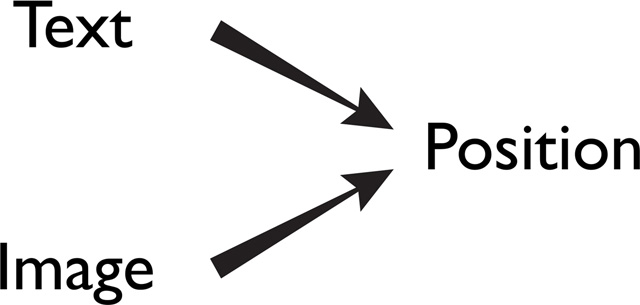
23 This triangle does not offer any additional arrows through combination as position is the end point of both, yet the third arrow is an obvious question, even having two options:
next...

24In both of these diagrams the new arrow could combine with one of the older ones to produce an arrow between two spaces. To have a diagram that commutes we need that arrow to be the same. In other words (taking the left-hand version) going from text to image, and then to position, should always give the same position as going directly from text to position. In other words, noting that position and text exist together causes a natural question of the link between the text and image at different positions. The dark words around the edge of the body strengthen this mapping, and themselves form sub-poems even as the letters are part of the longer poem.
The language and the image itself evokes other concepts, in particular (and unsurprisingly given the content of the image) notions of the human and the divine. In a central triangle on the image, black letters spell out “DEO” a clear arrow from the divine to text:
next...

25 This arrow combines with the one we formed above to link a notion of the divine to positions on the image. Those three positions, however, lie on the nipples and navel of the figure, some of the most human aspects of the body. In fact, it is unclear if the navel O is text or image. These are thus positions that are part of the arrow:
next...

La combinaison des deux diagrammes nous donne :
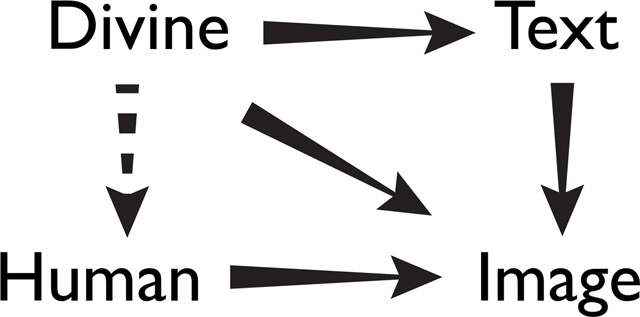
26 This presents us with a more subtle question: is there an arrow that maps from the divine to the human that will combine with the arrow from human to image to give the same result as our route from the divine, to text and then to image? This question, coming simply from identifying and combining arrows takes us from the image to one of the central meditations of Christianity, and certainly towards the artist’s intent in creating the image. This image and text become a puzzle to locate and relate the other links, ideas, and questions. Looking at each individually might not be hard, but one can get lost in the abstractions. Diagramming provides a tool to think about and discover other more subtle links, to see commonalities between links (as the same diagram repeats) and more (Coon 2016).
next...
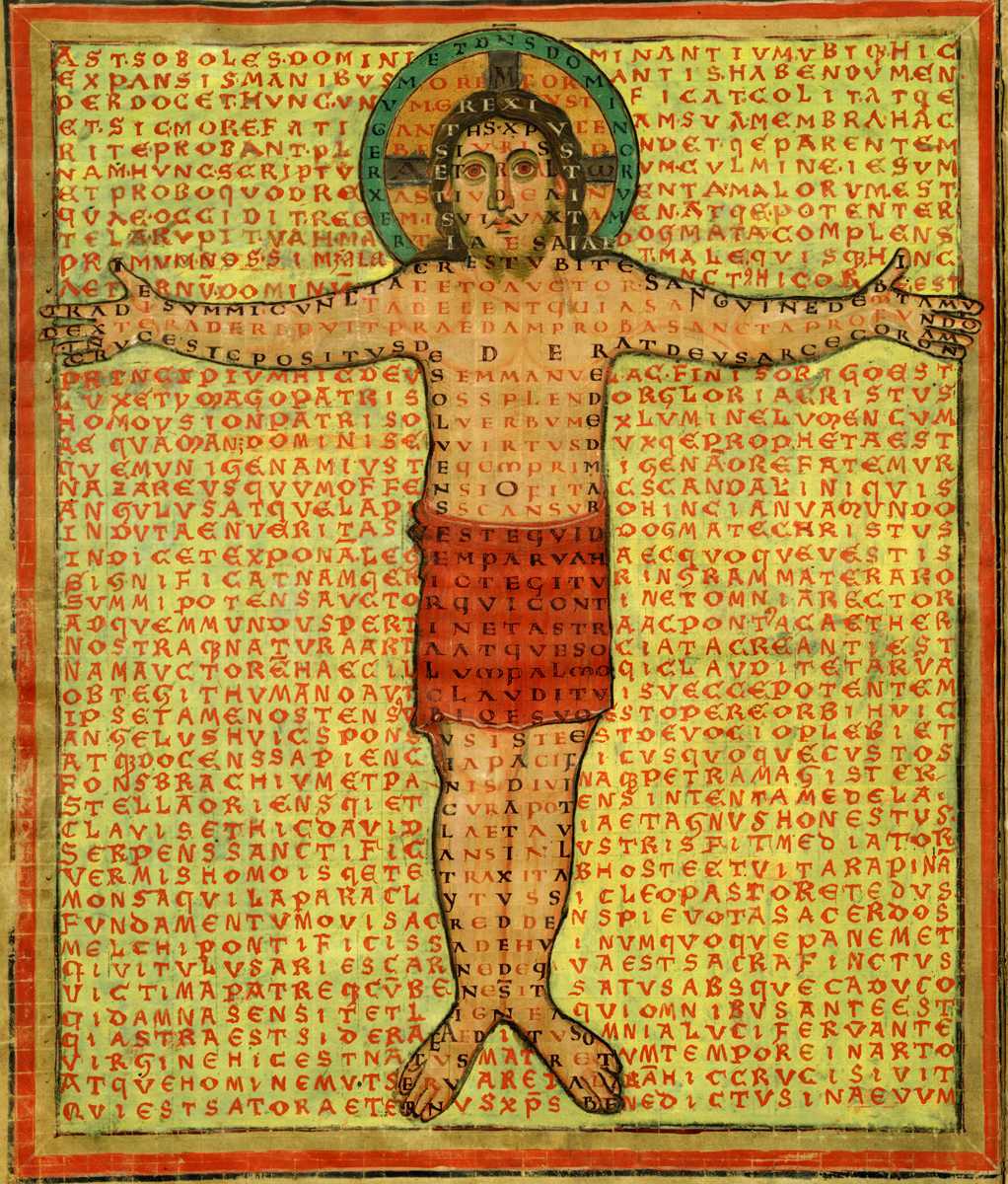
"Picture drawn from the book of Raban Maur, Louanges de la Sainte Croix, Berg International, 1988. (c) Library of the Vatican
V. Computer aided manufacturing (CAM)
27 The simplest map that can be considered here is the map from the space of physical objects to the space of machine movements. The map takes in some object and gives a list of instructions to the machine that will create that object. For most purposes this is the most practical approach and indeed is the set up used for most CAM software. When approaching and starting to use a machine, however, many people have a different thought: "How do I make the machine do this movement", which they demonstrate by a hand gesture. This sort of control is not possible with this single map as it would require a new space, that of geometric toolpaths on the computer. This space gives a very natural representation of the geometric movements that the machine will make, giving a very good representation. The original map can be recreated as a map from physical objects to toolpaths. The map from toolpaths to machine instructions can then be used to generate the machine instructions:
next...

28 The new intermediary space has the benefit of making the motion of the machine transparent since it retains the actual movement of the machine, rather than just the geometry of the finished object. In addition, it introduces the possibility to create new uses for the machine by replacing the map from physical object to toolpath. For example, the shape of the path can be used to pattern the surface of the finished object.
suite...
29 A less concrete example of the application of category theory comes from biomimesis (Thompson 2009), taking maps from the forms of nature onto architectural forms. Classically this has been achieved for static forms, such as the treelike support structures of the Sagrada Familia in Barcelona. To really understand and mimic the process, however, we need to go beyond the forms and start to explore the algorithms used by nature. We can make forms that grow like a tree rather than simply looking like one. We map the pattern of growth from a natural process onto an algorithm that can be run by hand or on a computer (Prusinkiewicz and Lindenmayer 1991). Understanding this mapping and the structure it preserves then enables the designer to step in. Not just to use the system to generate a collection of possibilities to select from, but to control the process and discover curious and beautiful examples.
Such possibilities are developed in the work of Achim Menges. He considers the form finding properties of natural materials like wood and creates a computer model that mimics the important structure. This creates two spaces, the material constructions and the computer model, with a map between them. The computer model enables an easy exploration of the design space, but many of the rules that it follows copy those of the material. As a result, the construction does not require complicated work as the rules to follow are already embedded in the materials being used (Menges 2012). A notable example is in his bent wood pavilion (Fleischmann 2012).
next...
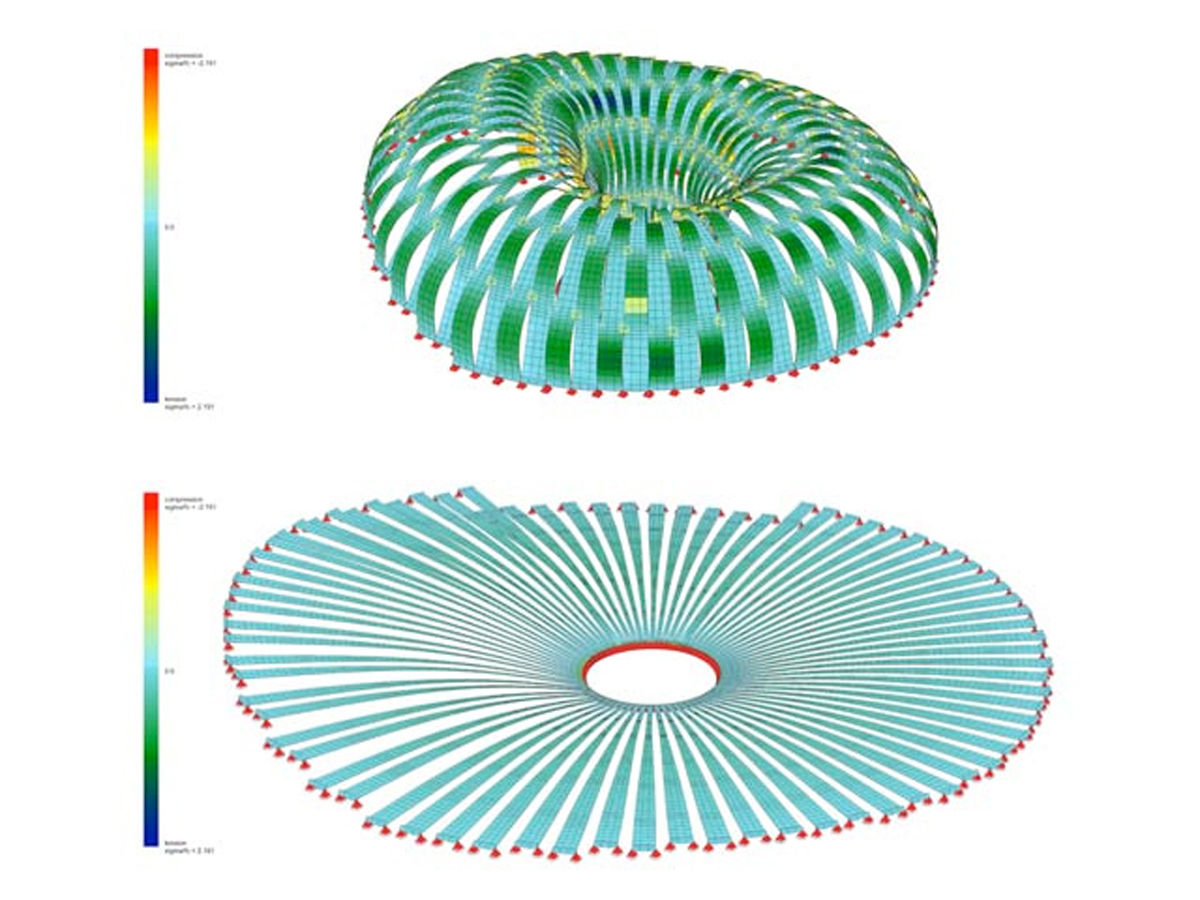
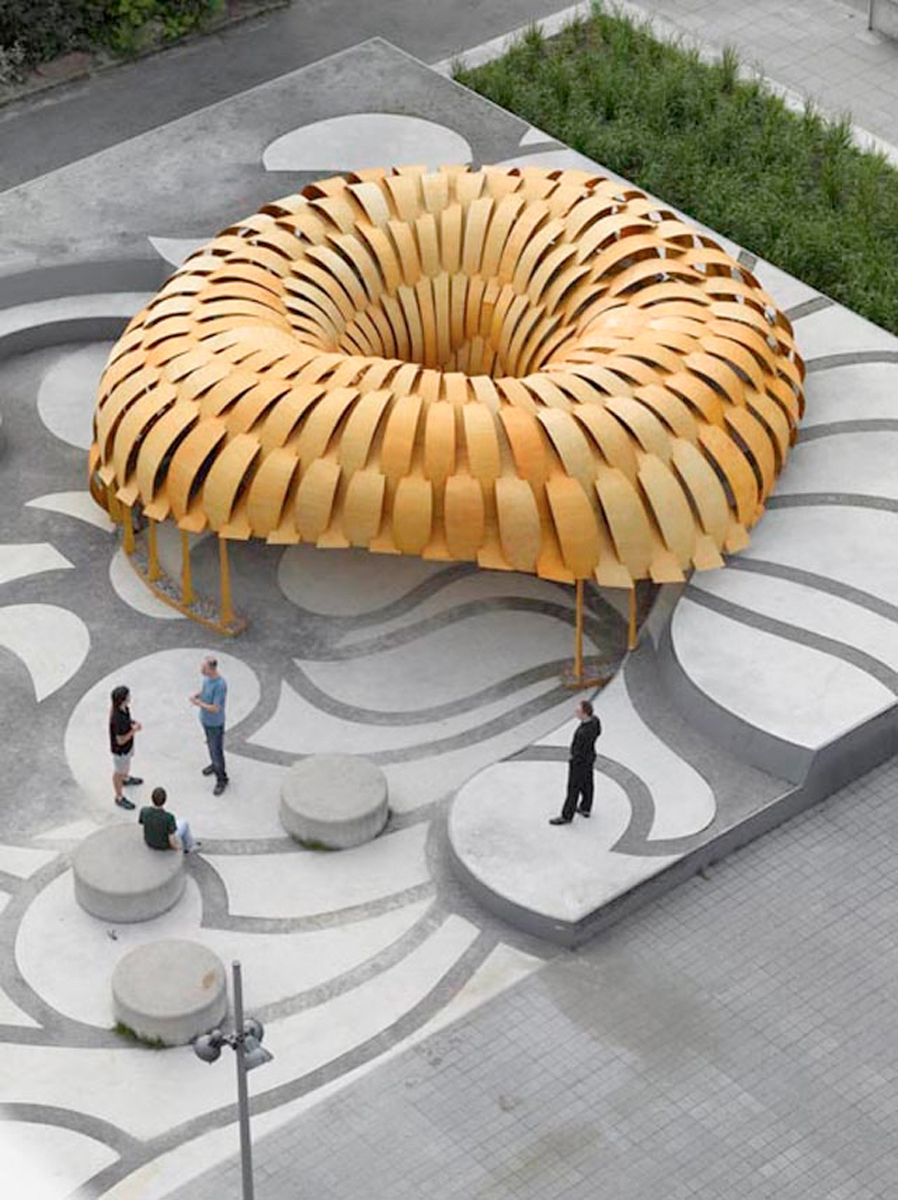
Images of Achim Menges’ Bent wood structure and computer model. The systems are set up so that any bend in one corresponds to a bend in the other. From http://www.achimmenges.net/?p=4443 © Achim Menges
30 The important structure in the two spaces here is the way that the objects (model or wood) bend. Each motion of the computer model corresponds to a model of the wooden one and vice versa:
next...
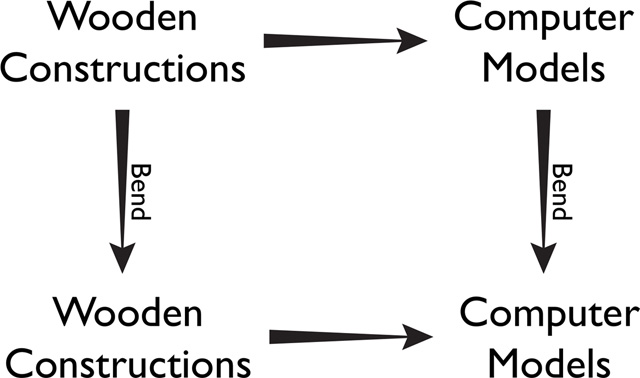
31 This well constructed map between different spaces, that retains the right structure, helps both in the design process while enabling new forms that are easy to build. In this case the map is provided by nature and people explore the connection it brings between spaces. Alternatively, a human generated algorithm can allow a selection of different forms within some given constraints. This form can then be optimised with respect to data coming from nature. The Swiss Re building, Foster’s “Gherkin” in London is a prominent, early, example of this thinking. It was designed as a parameterised model that could be varied while remaining true to the central idea of the architect. This space of potential buildings was then explored to see which were best adapted to the weather conditions. This gives two maps, from the space of parameters to the space of building shapes, and from that to numbers, encoding performance in the given weather conditions:
next...

32 The building with optimal performance can then be selected. The process of optimisation creates a new map, from weather conditions to optimal parameters:
next...

33 Due to the optimisation, the map from weather to building does preserve structure. With different weather conditions the shape of the building will change.
We could also break the optimisation down further as it would require creating a map from the weather to a computer model into which the building’s model can be introduced. This might be a standard model taking advantage of the scientific understanding of the weather. The computer is again essential to take advantage of such knowledge. It is on the computer that the different spaces and maps involved start to multiply. Each file format defines its own abstract space and each application provides a wide variety of maps. Different formats often cover similar spaces so we must map between them, trying to ensure that the structure needed is retained. Viewed this way, complex workflows can be mapped out and, if they are part of a more general project, can then be considered as a single map. Some of these maps might be part of a more general design project. Category theory, therefore, gives a single metaphor for often very different parts of the design process.
next...
34 Using software, however, can be a constraint as the only spaces and maps available on the computer are those defined by others. Programming is required to really explore new spaces and maps. Visual programming environments, such as the Grasshopper plugin for Rhino, provide an ideal way to explore these ideas. In these systems maps and spaces are considered explicitly, though the order is reversed from that given above. The boxes provide the maps and the lines joining them carry the spaces. For example, consider taking a mathematical function, using this to generate a collection of points, turning those into a curve in space and then producing a three-dimensional pipe. This process can be described in the diagrams given here:
next...

35 The same collection of spaces and maps implemented in Grasshopper would look like this:

36All these methods raise the question of authorship. At what stage does authorship pass from the creator of an algorithm to its user? One way to answer this question is to consider the spaces and structures that are involved. In a very simple space, such as the space of parameterised models for the Gherkin, it is clear that no amount of experimentation could take authorship from the algorithm writer. On the other hand, a general space such as the space of three-dimensional objects that can be explored in 3d modeling software would almost always give credit to the user. There is a trickier middle ground. When people first start to understand an environment like grasshopper, the designs they come up with are often quite similar to previous work. They are somehow derivative originals. The space of easily accessible opportunities opened up by the software contains certain obvious aesthetic peaks that many are drawn to. Such creations might not even have any clear author if, despite their repeatability, they go beyond the design intent of the software’s author. These questions will doubtless not be solved by category theory, but the theory does give us ways of considering them.
next...
VI. Some philosophical inspiration
37 The ideas considered here are grounded in perceptualism, and the notion of mathematics as a system of perception. This is modelled in Andy Goldsworthy’s classic Rivers and Tides (Riedelsheimer 2006), which follows simple observations deep into both metaphor and scientific models of landscape. This leads to a notion of an applied mathematics for art, contrasted to the purer forms of much mathematical art (Harriss et al. 2019).
That investigation itself links back to the academic play of Alfred Jarry and the College of ‘Pataphysics’ (Hugill 2012, Bok 2001). Putting the maps and diagrams here in the service of the art’s rigorous subjectivity could provide a potential model for ‘pataphysics, the “science of the particular”’ (Jarry 1965, 131). This is a topic that likes both to define itself and to form contradictions between its definitions. The notion of being a science of the particular is a classic example. The particular making the scientific method redundant, with its need for repetition, and thus generality. Another attempt at the appearance of a definition, however, does lead to a Category theory approach. If ‘pataphysics is to metaphysics as metaphysics is to physics (Jarry 1965), we have an arrow from ‘pataphysics to metaphysics and another map from metaphysics to physics. Yet here we are directly comparing the maps. Linking the two arrows means that we can consider a larger space of abstract worlds that contains physics, metaphysics and ‘pataphysics. This space also has an arrow to itself that takes physics to metaphysics and metaphysics to ‘pataphysics. We can then ask what happens to ‘pataphysics? Unwinding the chain, we then find a strange hierarchy:
next...

38 Though perhaps some would argue that this is exactly what the apostrophe at the start of ‘pataphysics implies, and thus there is nowhere further to go. This illustrates both a strength and weakness of category theory, its ability to consume itself, considering categories (or spaces) of categories and so on, and thus disappear down a rabbit hole of abstraction.
A more serious issue is the need to understand the current world and the increasingly central role that abstraction and algorithms are taking in it. While technical mathematics is clearly playing a role here, a broader understanding of its impacts on society is also required. To contrast with the mathematics of logical positivism, Matthew Handelman describes the need (and utility) for a negative mathematics to critique and study this social impact (Handelman 2019). Indeed, powerful examples of such critiques are emerging, for example Weapons of Math Destruction by mathematician Cathy O’Neil (O’Neil 2016) and, within mathematics education the call to rehumanise mathematics (Goffney and Guttierrez 2018).
The notion of category theory itself as a system for use beyond the abstract reaches of mathematics is well established. For those wishing to develop the ideas further Conceptual Mathematics by William Lawvere and Stephen Schanuel (2018) provides a more detailed and structured approach with a general reader in mind. A more philosophical take comes in Mathematics of the Transcendental by Alain Badiou (2014). A lighthearted approach is taken in How to Bake Pi by Eugenia Cheng (2016).
To finish, we return to the notion of exploring simpler structures. This can have another great benefit, revealing that seemingly disparate processes are intimately linked. Numbers themselves are an example of this. We do not need separate systems for sheep, goats, and coffee cups. By learning to count once we can apply the system to everything. In terms of category theory, we have a map from:
next...
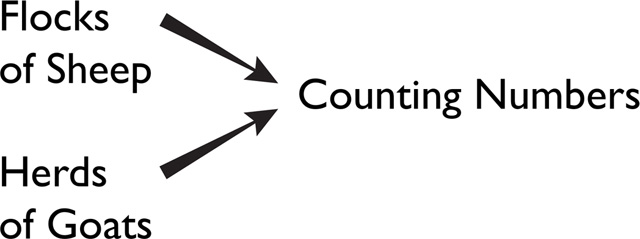
39 This map respects structure as the operation of combined two collections to make a larger one corresponds to adding their respective counts. This idea was developed for more subtle systems by Gilles Deleuze in his concept of engineering diagrams (Deleuze 1994). Manuel De Landa (2000) gives an example by considering crystals and bubbles. These are quite different objects, initially it appears that the rules governing the positions of atoms in each form are distinct. Yet when those atomic interactions are considered in terms of energy minimisation it becomes apparent that both sets of rules share significant structure:
next...

40In the spirit of the game we describe we hope you are already thinking now about the possible maps between flocks and herds, crystals and bubbles.
For an artist or designer, the ability to spot that two different systems have important similarities is an essential one. It can reduce the amount of work required and allow surprising new advances, as the intuitions and ideas of each area can be translated into the other.
next...
Bibliography
41
Alberti, Leon Battista, 2004, L’Art d’édifier, Paris, Seuil (translated by P. Caye et F. Choay).
Albers, Anni, 1965, On Weaving, Portland, Wesleyan University Press.
Badiou, Alain, 2014, Mathematics of the Transcendental, London, Bloomsbury Academic.
Bok, Christian, 2001, ‘Pataphysics’: The Poetics of an Imaginary Science. Evanston, Northwestern University Press.
Carpo, Mario, 2011, The Alphabet and the Algorithm, Cambridge, The MIT Press.
Cheng, Eugenia, 2016, How to Bake Pi, New York, Basic Books
Coon, Lynda, 2016, "Gendering Dark Age Jesus" Gender & History, Vol.28 No.1 April 2016, pp. 8–33.
Deleuze, Gilles, 2012, Différence et repetition, Paris, PUF.
DeLanda, Manuel, 2000, "Deleuze, Diagrams, and the Genesis of Form", Amerikastudien / American Studies Vol. 45, No. 1, pp. 33-41.
Fleischmann, Moritz, Knippers, Jan, Lienbard, Julian, Menges, Achim and Simon Schleicher, 2021, "Material Behaviour: Embedding Physical Properties in Computational Design Processes" Architectural Design March/April 2012 pp 44-52.
Goffney, Imani and Rochelle Gutiérrez (Eds), 2018, Rehumanizing Mathematics for Black, Indigenous and Latinx students. Reston (VA), National Council of Teachers of Mathematics.
Gray, Jeremy, 2008, Plato’s Ghost, Princeton, PUP.
Harriss, Edmund, Smith, Carl and Angela Carpenter, 2019, "Geometry in the walnut grove: an applied mathematical approach to art." Journal of Mathematics and the Arts” Jan 2019, pp. 152-172.
Handelman, Matthew, 2019, The Mathematical Imagination, New York, Fordham University Press.
Hugill, Andrew, 2012, ‘Pataphysics: A useless guide, Cambridge, MIT Press.
Jarry, Alfred (Roger Shattuck and Simon Taylor, Editors), 1965, Selected Works of Alfred Jarry, New York , Grove.
Lawvere, F. William and Stephen H. Schanuel, 1998, Conceptual Mathematics, Cambridge, Cambridge University Press.
Lewis, David, 1994, We, the Navigators: The Ancient Art of Landfinding in the Pacific, Hawaii, University of Hawaii Press.
MacLane, Saunders, 2010, Categories for the Working Mathematician (2nd edition), New York, Springer.
Manin, Yuri, 2007, Mathematics as Metaphor (Collected Works), Providence, AMS.
Maur, Raban, 1988, Louanges de la Sainte Croix, Berg International, Paris Trois-Cailloux, Maison de la Culture, Amiens.
Menges, Achim Menges, 2012, "Material Generation" ACADIA 12: Synthetic Digital Ecologies pp. 21-24.
Nargi, Lela, 2011, Knitting Around the World: A Multistranded History of a Time-Honored Tradition, Mineapolis, Voyageur Press.
O’Neil, Cathy, 2018, Algorithmes : La bombe à retardement, Paris, Les Arènes.
Prusinkiewicz, Przemyslaw, Lindenmayer, Aristid (Eds), 1991, The Algorithmic Beauty of Plants, New York, Springer.
Riedelsheimer, Thomas, 2006, Rivers and tides : Andy Goldsworthy et l'oeuvre du temps, Compagnie des Phares et Balises.
Taruskin, Richard, 2009, Music from the Earliest Notations to the Sixteenth, Oxford, Century Oxford University Press.
Thompson, D’Arcy Wentworth, 2009, Forme et Croissance, Paris, Seuil.
> back to top of article...


